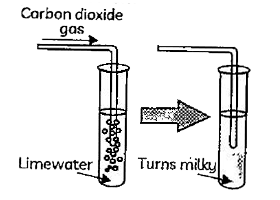Case 1 : Apoorna took a lime solution and passed a gas 'X' through it .The solution becomes turgid . This solution was then divided into two parts In the first part ,more of gas 'X' was passed .While in the second part concentrated sulphuric acid was added . A white precipitate was fromed in second part

Lime water and chlorine reacts to form :
CaCl2
CaOCl2
Ca(ClO3)2
CaO2Cl2
The correct Answer is:B
Lime water reacts with chlorine to form CaOCl2(bleaching powder).
Ca(OH)2+Cl2→CaOCl2+H2O
Topper's Solved these Questions
Similar Questions
Iron filings and sulphur were mixed together and divided into two parts, 'A' and 'B'. Part 'A' was heated strongly while part 'B' was not heated. Dilute hydrochloric acid was added to both the parts and evolution of gas was seen in both the cases. How will you identify the gases evolved?
View SolutionIron filings and sulphur were mixed together and divided into two parts, 'A' and 'B'. Part 'A' was heated strongly while part 'B' was not heated. Dilute hydrochloric acid was added to both the parts and evolution of gas was seen in both the cases. How will you identify the gases evolved?
View Solution
Knowledge Check
- Question 1 - Select One
When H2S gas is passed through an ammonical salt solution X, a slightly white precipitate is formed.The X can be:
Aa cobalt saltBa lead saltCa zinc saltDa silver salt - Question 2 - Select One
Statement-1 : On passing CO2 gas through lime water, the solution turns milky.
Statement-2 Acid Base (neutralisation) reaction takes place.AStatement-1 is tru, statement-2 is true and statement-2 is correct explanation for statement-1BStatement-1 is true, statement-2 is true and statement-2 is is NOT the correct explanation for statement-1.CStatement-1 is true, statement-2 is falseDStatement-1 is false, statement-2 is true. - Question 3 - Select One
When H2S gas a passed through an ammonical salt solution X, a slightly white precipitate is formed. The X can be:
Aa cobalt saltBa lead saltCa zinc saltDa silver salt
Iron filings and sulphur were mixed together and divided into two parts, 'A' and 'B'. Part 'A' was heated strongly while part 'B' was not heated. Dilute hydrochloric acid was added to both the parts and evolution of gas was seen in both the cases. How will you identify the gases evolved?
View SolutionWhen H2S gas a passed through an ammonical salt solution X, a slightly white precipitate is formed. The X can be:
View SolutionA white solid P, on strong heating, decomposes to give reddish brown gas R and a residue Q. The residue R is yellow when hot and white when cold. The solution of white solid P in water gives white precipitate S, with concentrated sodium hydroxide. The white precipitate S dissolves in excess of sodium hydroxide solution to form colourless solution.
Another sample of the solid P in water is mixed with ferrous sulphate solution and then to this solution are added a few drops of conc. sulphuric acid. A brown ring is formed at the junction of liquids. Answer the following questions:
Name the coloured gas R.View SolutionWhen H2S gas is passed through an ammonical salt solution X, a slightly white precipitate is formed. The X can be :
View SolutionA 150 mL of solution of I2 is divided into two unequal parts. I part reacts with hypo solution solution in acidic medium. 15 mL of 0.4 M hypo was consumed. II part was added with 100 mL of 0.3 MNaOH solution. What was the initial concentration of I2 ?
View Solution

